One of my favorite boreka fillings is eggplant and cheese or Handrajo. The smokiness of roasted eggplant combined with sharp cheese makes a sophisticated filling. These borekas are made just like the cheese and potato filled ones with the only difference being the roasted eggplant.
1 and 2/3 cup of roasted eggplant pulp without seeds
8 ounces Feta cheese
4 ounces of kosher Monterey Jack cheese or Cheddar cheese (sharp), grated
1 cup Parmesano Reggiano cheese, finely grated
2 eggs
Dough:
4 cups of all purpose flour
2 teaspoons salt
1 cup ice cold water
3/4 cup vegetable oil (I use safflower)
1 beaten egg
Preheat oven to 400 degrees.
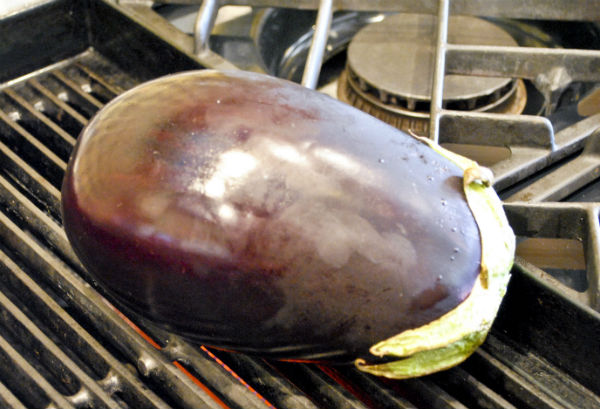 Look for large, firm, heavy, super shiny eggplant. I used one very large egghplant, but several smaller ones work just fine. You need firm and heavy to assure a good amount of seedless pulp, since spongy ones tend to be full of seeds and bitter. Roast the eggplant over an open flame, in a 350 degree oven or on the barbecue. When it is totally soft with liquid oozing out, remove it from the heat source and wrap it in foil for 10 minutes. Unwrap the eggplant and peel off the charred skin. Remove the tough stem end. Open the eggplant pulp up flat on a cutting board and remove any seed veins. Chop the eggplant finely on the cutting board.
Look for large, firm, heavy, super shiny eggplant. I used one very large egghplant, but several smaller ones work just fine. You need firm and heavy to assure a good amount of seedless pulp, since spongy ones tend to be full of seeds and bitter. Roast the eggplant over an open flame, in a 350 degree oven or on the barbecue. When it is totally soft with liquid oozing out, remove it from the heat source and wrap it in foil for 10 minutes. Unwrap the eggplant and peel off the charred skin. Remove the tough stem end. Open the eggplant pulp up flat on a cutting board and remove any seed veins. Chop the eggplant finely on the cutting board.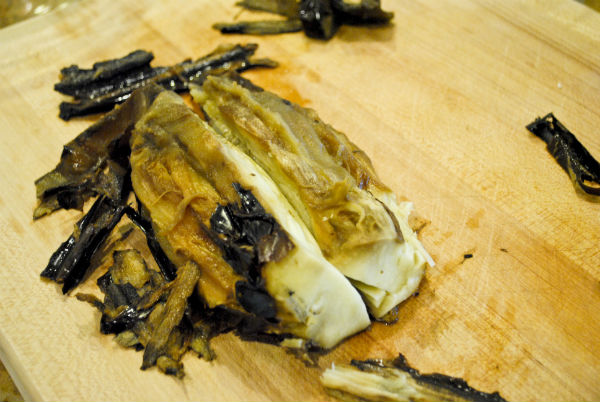
Place the eggplant in a bowl and then crumble the feta cheese on top. Add the grated Cheddar and one half of the Parmesan; reserve the rest of the Parmesan for sprinkling on top of the borekas before they go in the oven. Combine the cheese with the slightly warm eggplant and then add the eggs. Stir to combine. Place the bowl in the microwave for 1 minute and a half and warm the mixture through. The heat will melt the cheeses a bit. Set the filling aside to cool in the refrigerator. The filling firms up as it cools.
For the dough, combine the flour and salt in a mixing bowl. Whisk the cold water and oil together in a two cup glass measure. Add the liquid to the flour. Gather the dough together in a ball with your hands, making sure all is incorporated. Separate the dough into 42 walnut size balls. Using your fingers roll the balls until smooth. Smooth balls roll out easier and more uniform, when you make the flat rounds to fill. Roll each ball out to about a 3 inch round using a wooden rolling pin. You can do this on a wood or stone surface. Take care not to roll the rolling pin over the edges of your rounds or the edges will be thin and centers thick.
You will need 2 one half sheet baking pans. You can use the pans plain or I prefer to use silpat liners. Place a tablespoon of filling in the center of each round of dough. Portion out the filling to accommodate the 42 balls you have made. The filling amount should be just about right, if you have a little leftover do not overstuff the borekas. Fold the rounds in half. Pinch the edges shut and twist the edge forming a rope design (repulgo). Place 21 on each baking sheet (3 columns of seven). Space them evenly on the baking sheet. Beat the last egg in a bowl for an egg wash and then brush each one with a little bit. Sprinkle with grated parmesan cheese. Bake for approximately 15 to 20 minutes or until pretty and golden. Remove from the baking sheets and place on cooling racks.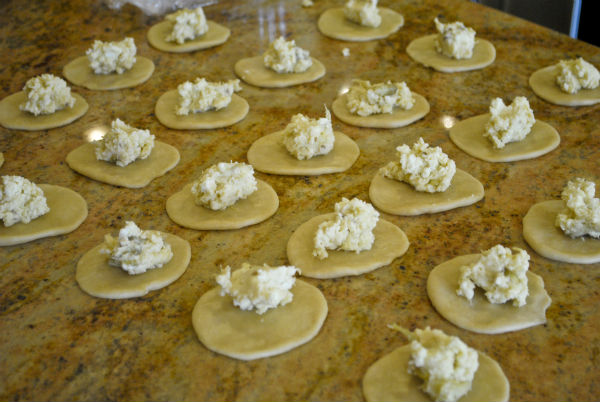
Borekas may be frozen and reheated.

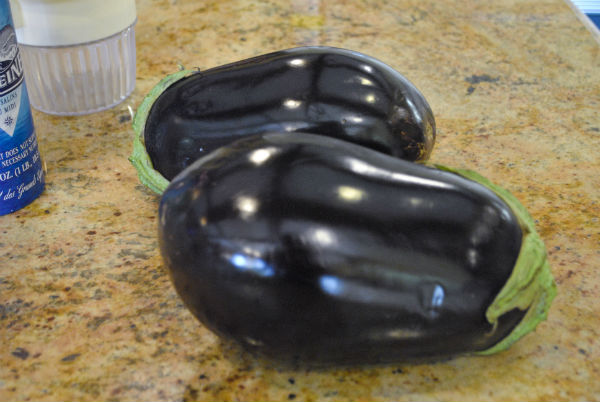




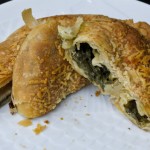

Your blog is so very aptly named – these latest borekas of yours are beautiful even just to look at! I’ve never been a big fan of eggplant, but looking at these photos, I can already taste how gorgeous they will be when I bake up a batch. Thanks for sharing this, Linda. Your food photography is truly praise-worthy in the highest order.
I have been following your blog for a while now and enjoy the recipes. I just wanted to correct something in the May 23 post. Handrajo is the name given to borekas with an eggplant, zuccini and tomato filling. They originated in Izmir. The ones you describe in your recipe are “Borekitas de berencena”.
Thank you so much for your comment. I didn’t realize that. Many recipes vary from town to town. I think that many recipes also became altered in the American migration, based on availability of ingredients and other factors. My family has been in the United States since 1909 and my parents are American born so perhaps something was lost in translation. I know that there are other words for eggplant, like berejena. merenjena, patlijan or hatzilim depending on the where and when circumstances. I hope you continue to read and send in your information. I love it. Thanks Linda